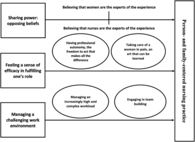Family centered nursing practices towards women and their families in the birthing context: A qualitative systematic review
- PMID: 37306178
- PMCID: PMC10416028
- DOI: 10.1002/nop2.1880
Family centered nursing practices towards women and their families in the birthing context: A qualitative systematic review
Abstract
Aim: Synthesize qualitative evidence examining how nurses' attitudes, beliefs, and sense of efficacy and the context surrounding birth facilitate or hinder family-centered nursing practice.
Design: Thematic synthesis of qualitative studies.
Methods: A literature search was conducted in CINAHL, MEDLINE, PsycINFO, SCOPUS, SCIENCE DIRECT, REPÈRES, CAIRN, and ÉRUDIT from October 2020 to June 2021. The PRISMA guidelines were followed, and studies were critically appraised using the Critical Appraisal Skills Programme checklist. Data were extracted by two independent reviewers, and Thomas and Harden's qualitative thematic synthesis method was performed for data analysis.
Results: Thirteen studies were included. Three analytical themes were generated: (1) sharing power: opposing beliefs, (2) feeling a sense of efficacy in fulfilling one's role, and (3) managing a challenging work environment.
Patient or public contribution: Synthesizing nurses' experience is essential to promote implementation of favourable changes for care that is more focused on the needs of families.
Keywords: attitude of health personnel; family practice; labour; nurse-patient relations; nurses; obstetrics; power; qualitative systematic review; self-efficacy; workplace.
© 2023 The Authors. Nursing Open published by John Wiley & Sons Ltd.
Conflict of interest statement
No conflict of interest has been declared by the authors.
Figures
References
-
- Baptista, M. K. S. , Santos, R. M. d. , Costa, L. d. M. C. , Macêdo, A. C. d. , & Costa, R. L. M. (2018). The power in the nurse‐patient relationship: Integrative review. Revista Bioética, 26(4), 556–566. 10.1590/1983-80422018264274 - DOI
-
- Baxter, J. (2020). An exploration of reasons why some women may leave the birth experience with emotional distress. British Journal of Midwifery, 28(1), 24–33. 10.12968/bjom.2020.28.1.24 - DOI
Publication types
MeSH terms
LinkOut - more resources
Full Text Sources



